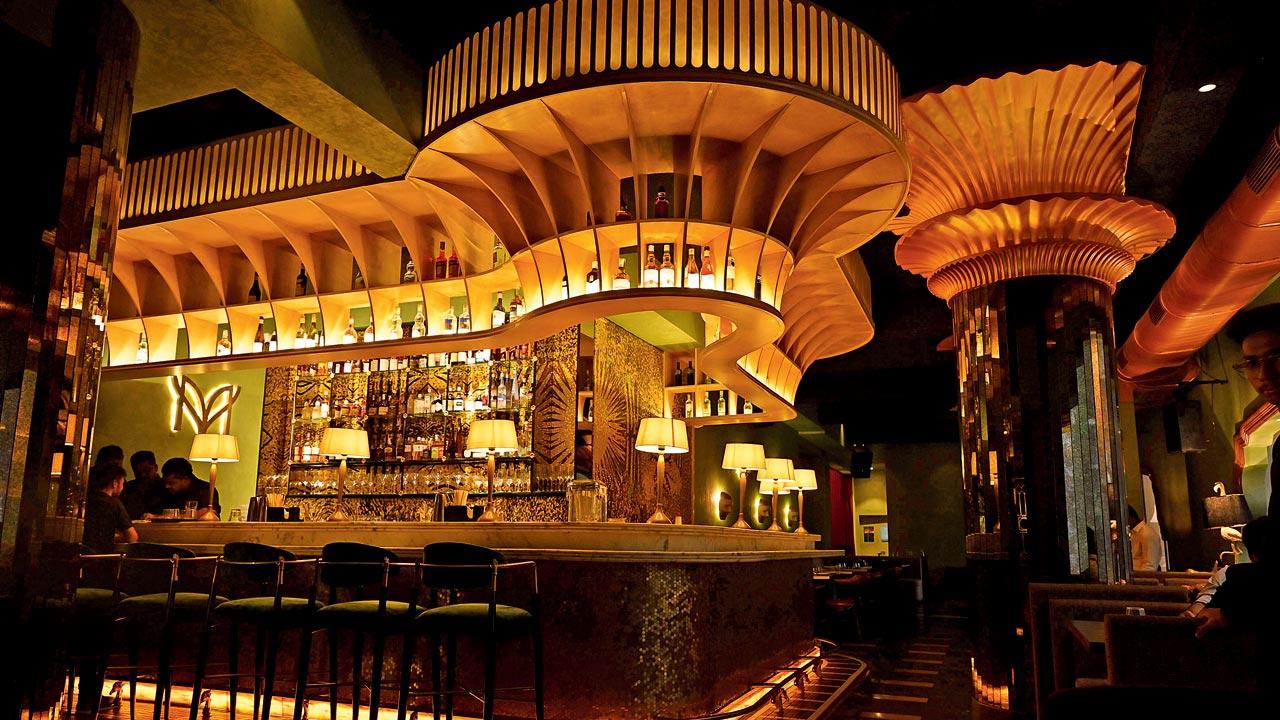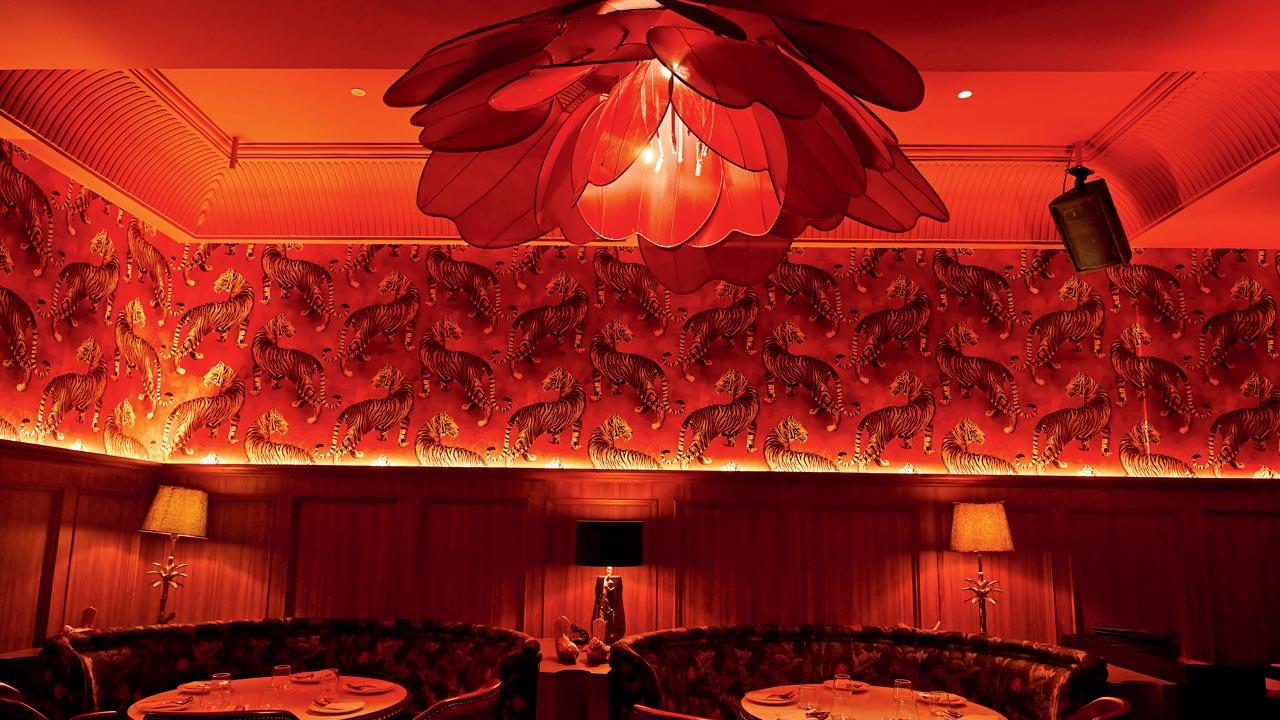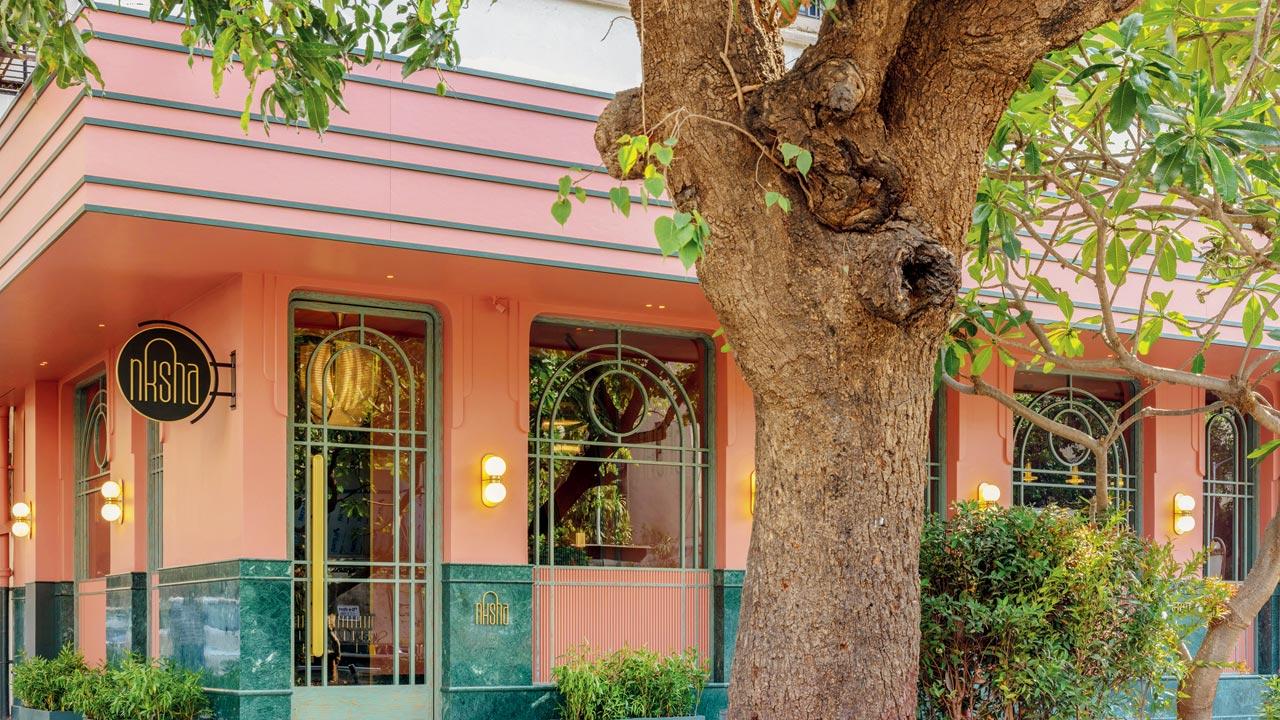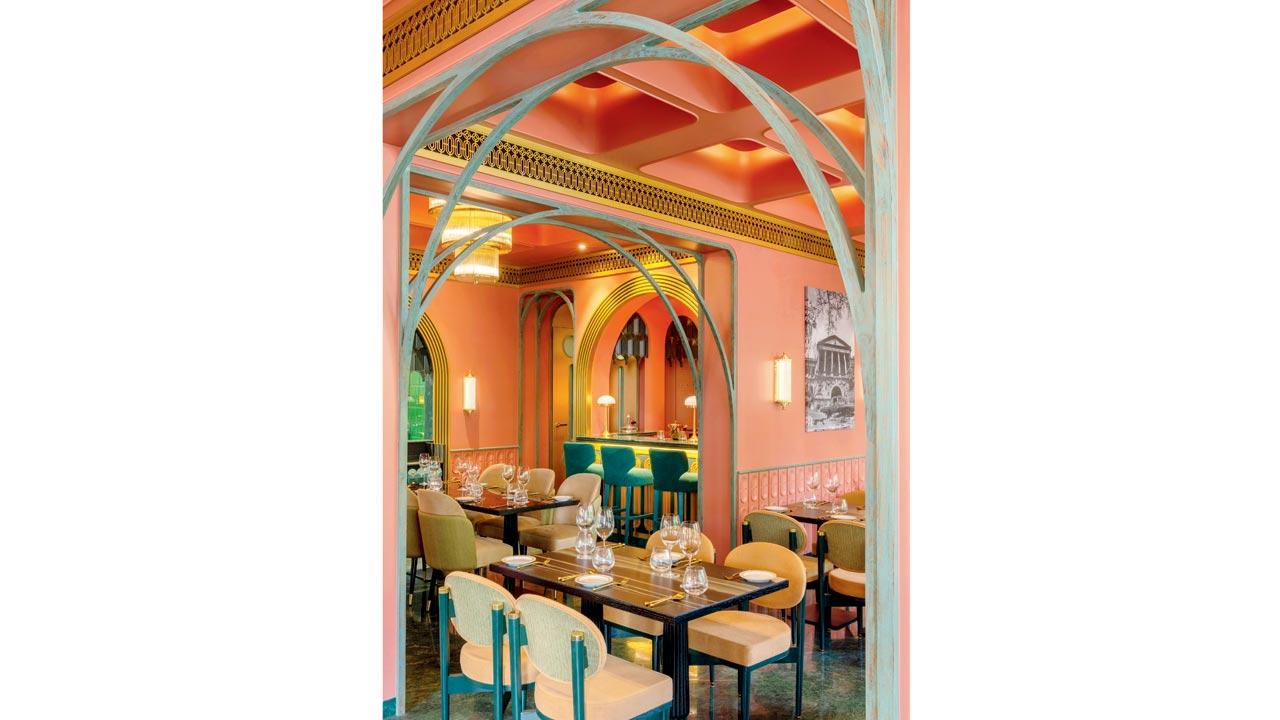The chic, simple and classy curves of Art Deco are being embraced by restaurants who want to carry forward the design tradition

Nksha
Mumbai's low-rise apartment blocks have earned it the tag of possessing the most number of Art Deco buildings in India, and second in the world. Month after month, however, the city’s Art Deco buildings which don’t have heritage protection are vanishing.
The buildings on Marine Drive and the blocks around Oval Maidan gained the UNESCO World Heritage Site tag in 2018, so they remain untouched. But Mohammed Ali Road, and neighbourhoods like Shivaji Park, Matunga, Sion and Bandra, are losing their architectural style with every new redevelopment project.
 Muze speaks the language of opulence. Pic/Atul Kamble
Muze speaks the language of opulence. Pic/Atul Kamble
However, Art Deco is not completely vanishing as the city’s skyline changes. Instead, it has shifted—and its new address is not a tall building, but interiors of restaurants.
Muze, which opened at Gabbana House in Khar West in March, draws from the Flapper Girl era of the 1920s. The owners, Gen Z sisters Saloni and Anannya Shelar, were inspired by the bold, liberated flapper girl. As flappers embraced Art Deco’s geometric forms, bold colours and streamlined silhouettes in their clothing and accessories, naturally, the interiors of Muze had to wear that style as well.
 The designer employed luxurious finishes and a touch of theatrical flair for Muze. Pic/Atul Kamble
The designer employed luxurious finishes and a touch of theatrical flair for Muze. Pic/Atul Kamble
As one walks in, the steps up the first floor instantly remind you of the glamour and opulence of the era. Upon entry, throughout the space, dramatic Art Deco-inspired columns take centre stage, wrapped in antique mirror and metallic gold detailing intended to flow like abstract floral forms. At the bar, a bold gold mosaic-tiled counter commands attention. Look up, and you see a sweeping shape, like a flowing ribbon. The furniture across the space is intentionally eclectic, and no two pieces are alike. You will witness vibrant prints, rich velvets, supple leathers, warm wood, and gleaming brass all over.
Mumbai-based boutique design studio DesignWorx has chalked out Muze’s interiors and has managed to draw from Art Deco elements one would witness in Paris or New York. “[Art] Deco was the heartbeat of our design concept for Muze. [This] rich source of inspiration allowed us to play with bold geometry, luxurious finishes, and a touch of theatrical flair,” explains Shaji Arakkel, founder of DesignWorx.
 Atul Kumar, founder trustee, Art Deco Mumbai
Atul Kumar, founder trustee, Art Deco Mumbai
The design studio has woven in the drama and detail that you don’t see in Mumbai’s buildings. The motifs like sleek leopards, vibrant parrots, and elegant cheetahs give the space an exotic feel, and are a nod to its Euro-Asian menu. But other elements of the interiors echo the glamour of 1920s Deco style: Deep emeralds, burnished golds, and inky blacks. Muze showcases the opulent Art Deco of the Jazz era, a rarity in the city.
Mumbai’s residences, palaces, hotels, and cinemas, all built between 1930 and 1950, are not as grand as the Jazz Age. Instead, they represent tropical Art Deco, like Miami, showcasing stylised forms of waves, sunburst rays, and tropical flora and fauna.
 Nksha exudes a retro charm right away
Nksha exudes a retro charm right away
In Colaba, the Third Wave Coffee outlet represents the style with its geometric gate, door, and foyer. In Churchgate, where the heart of Mumbai’s Art Deco lies, Gaylord has renovated to add geometric patterns and lines in its ceiling panels and arches, while a few steps away, Nksha has upheld the style even in its logo.
While you don’t see tropical elements of the architectural style in the restaurants of today, the representation of Art Deco is unmissable even if you are not too familiar with the style. “It felt important to honour that context and respond to our surroundings in a meaningful way,” says Pranav Rungta, co-founder and director of Nksha and vice president of the National Restaurant Association of India (NRAI).
 The décor at Nksha forms a backdrop to a forward-looking dining experience
The décor at Nksha forms a backdrop to a forward-looking dining experience
While designing Nksha, the team was drawn to the architectural style’s symmetrical geometries, stepped motifs, fluted textures, and use of metals and marble. The ceiling patterns, custom lighting, and marble flooring at Nksha all echo classic Art Deco elements, but are done with a restraint to suit today’s aesthetics. “The Art Deco cues are present, but they don’t overwhelm. They serve as a backdrop to a dining experience that’s elegant, uncluttered, and forward-looking. The colour tone too, which the designers Shruti and Neesha chose, has hues of traditionalism as well as contemporary, which worked perfectly,” says Rungta.
He adds that as Nksha sits in the Art Deco district, representing that style was a clear design direction. Diners, too, notice it. “The responses are overwhelmingly positive. Some [diners] notice the detailing, others just say it ‘feels like Bombay’. That emotional connection and that sense of familiarity and pride are exactly what we hoped to evoke,” he says.
Atul Kumar, founder trustee of the non-profit organisation Art Deco Mumbai, thinks that the idea that restaurants are adopting the style is exciting. However, he doesn’t think it’s correlated to the city’s development as an Art Deco capital of the world. “I think it’s more one-off. It’s more the fact that the style is still contemporary, it’s still chic. So designers take to it. It’s clean. It’s simple. It’s classy. You don’t say, ‘this is a 1930s restaurant’, right? You go in there and you say, ‘Oh, wow, this looks lovely.’ There’s no acknowledgement that this was the staple style of the city ever since the 1930s. I think for me, it’s a testimony to the timelessness of the style,” he says.
This is noteworthy as tomorrow marks 100 years since Art Deco was first celebrated. In 1925, the International Exhibition of Modern Decorative and Industrial Arts in Paris highlighted the modern style of architecture, interior decoration, furniture, glass, jewellery and other decorative arts in Europe and worldwide. This modern style came to be referred to as Art Deco, later in the ’60s.
But for restaurants, the reasons for adopting Art Deco are different. It’s not always about homage—for many, it’s the sophistication that the style embodies.
Rungta, however, adds, “Not just restaurants, the retail industry generally has been conscious of keeping historic design languages relevant.”
Naturally, this comes with some hurdles. “One of the key challenges was finding the balance between staying true to the essence of Art Deco and meeting the practical demands of a modern dining space. While we were committed to honouring the style, it was just as important to ensure the space functioned seamlessly with the expectations of today’s hospitality experience,” says Arakkel.
So, is this one way of preserving the style? Kumar doesn’t believe so. Instead, he cites Eros Cinema as a better example of preservation. The 1935 building was restored with the help of a conservation architect on board. The equipment was modernised, but the external integrity of the properties was intact. “It looks magnificent in the day, and at night, it’s lit up beautifully, and it kind of reminds you of the kind of glory of Churchgate,” says Kumar.
Rungta believes that restaurants may not help preserve styles or compensate for the loss of heritage. But, they can contribute in some way. “We can act as stewards of design traditions, and we can inspire others to value the old even while building the new. It’s about carrying forward a narrative, not replacing it.” This is also because, as Arakkel put it, “[There is] a shift in the restaurant industry where nostalgia and cultural memory are becoming key design elements. Many contemporary dining spaces are drawing inspiration from historical references and local heritage, crafting environments that not only evoke a sense of personal connection but also offer a truly distinctive dining experience.”
 Subscribe today by clicking the link and stay updated with the latest news!" Click here!
Subscribe today by clicking the link and stay updated with the latest news!" Click here!








